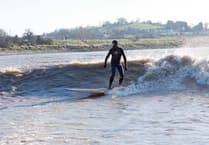The current ‘Ebb and Flow’ exhibition at the George café, Newnham, highlights the severe pollution endangering the health of our rivers. For many reasons, the situation is deteriorating and exposing increasing dangers to the safety of our water supply and to the wild life and the human industry which need healthy rivers.
The George has emerged as an important local cultural centre, and hosts music, drama, and lively presentations by experts on local matters of interest. It is also an art gallery, where works of local interest and by local artists are exhibited. The current ‘Ebb and Flow’ exhibition has attracted artists to illustrate our two great rivers, the Severn and the Wye, and to expose the dangers they are facing. These are the ‘Two Rivers’ referred to in the ‘Land Between Two Rivers’ anthem, as celebrated by the great Forest poet, the late Dick Brice, the Forest of Dean poet laureate. Sadly these rivers are now dying, and are in urgent need of revival.
The Armoury Hall at Newnham joins in the riverine festival, with, as performed at the Wye Valley Musical Festival, Love Letter to the Wye, by Fiona Taylor and Friends on Thursday, September 19. The Ebb and Flow exhibition concludes with a great pilgrimage from the George to the River Severn on Saturday, September 21 at 5pm, with various performances and symbolic gestures offering revival to the river.
There have been similar protests on the River Wye. In Herefordshire, there have been events in Ross and further up the river mourning the decline of the health of the Wye and its tributary the River Lugg. The Wye weaves its way through Gloucestershire along the Welsh border, and along the way, the goddess of the Wye, Vaga the Wanderer, appeared at a Redbrook event as a giant puppet, starring in the Redbrook Riversong event organised by the Save the Wye group. The interactive puppet, made by master puppet maker and environmental arts activist Kim Kaos, was heralded by the Forest Thump samba band and it is reliably recorded there that - The goddess told us: ‘I am the Wye and speak for all life that depends on a clean river – the salmon, the kingfisher, the crayfish, the water crowfoot, and indeed you humans too.’
Sabrina was not only a 1950s film star, but was also the name of the Roman goddess of the River Severn, depicted as half woman half fish at the old Tintern Station Heritage Centre, along with other famous local celebrities, mythological, legendary and actual. It is not clear why the goddess of the Severn was transported to her final resting place in Tintern which is on the banks of the River Wye. The Wye has its own goddess, the less well known ‘Vaga the Wanderer’, as celebrated at Redbrook. But I’m sure that the Severn goddess would concur with this statement by her colleague Vaga in her demand for clear river water.





Comments
This article has no comments yet. Be the first to leave a comment.